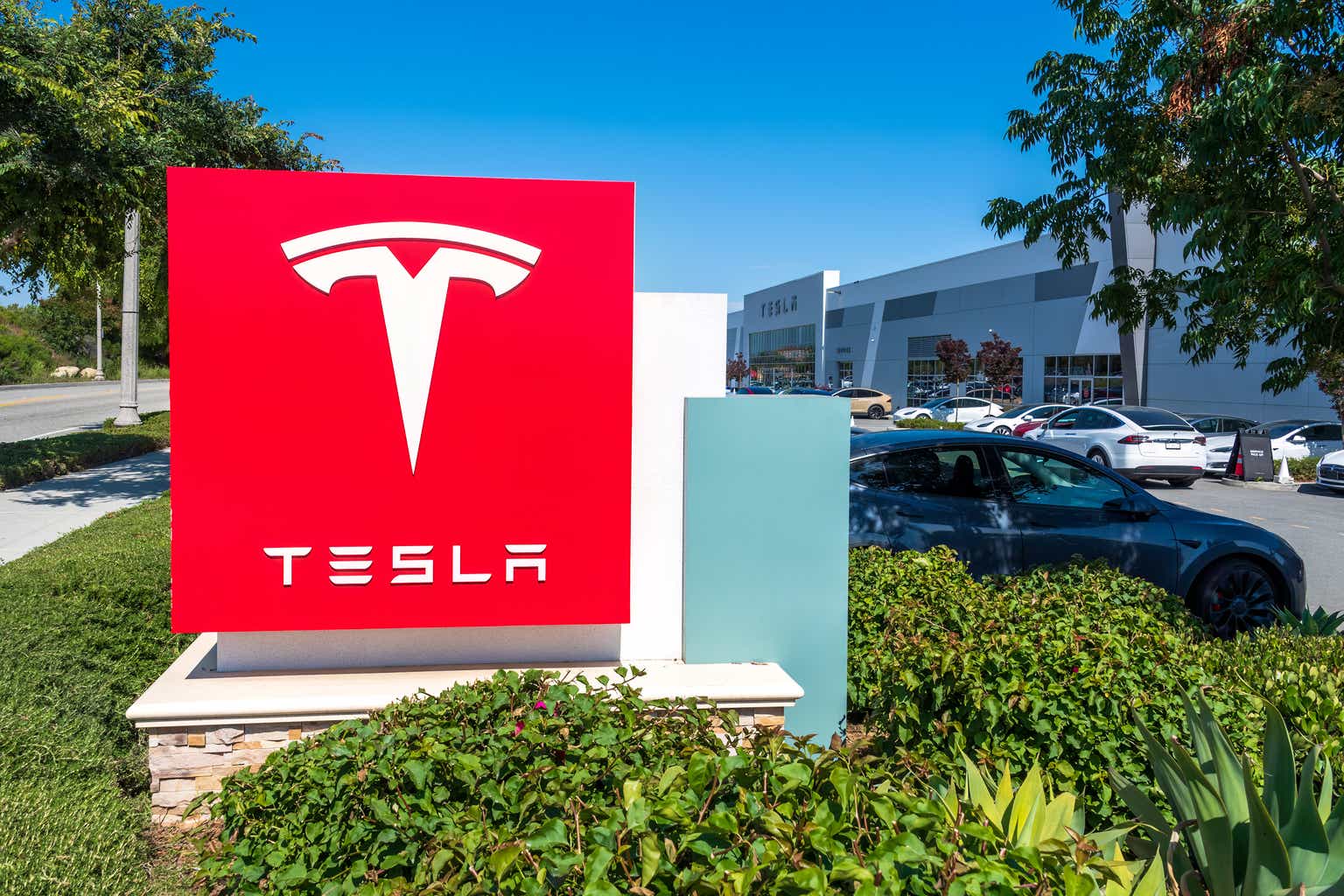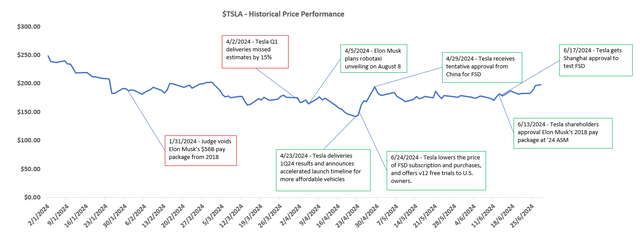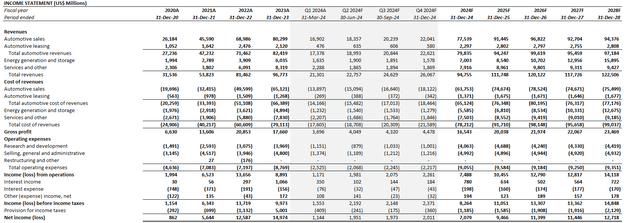baileystock
Tesla, Inc. (NASDAQ:TSLA) has handily beat expectations on 2Q24 deliveries, albeit a low bar set after repeatedly lowered consensus estimates. The company delivered 443,956 vehicles during the June quarter, which represented a -5% y/y decline and 15% sequential expansion. The results compared to the average Wall Street delivery estimate of about 430,000 vehicles, and were well within expectations that Tesla was in for its second consecutive quarter of delivery declines for the first time. The results also conclude a modest first half of the year for Tesla in terms of automotive sales, which effectively puts the company’s auto unit sales growth prospects for the year – as previously promised with confidence by CEO Elon Musk – at greater risk. The stock’s response to Tesla’s 2Q24 delivery results was also favorable.
This is corroborative of returning investors’ interest towards Tesla’s full self-driving (“FSD”) and robotaxi realization prospects. Recall from our previous coverage’s discussion that Tesla’s stock valuation has long decoupled from vehicle sales. And this decoupling has become especially clear in recent quarters, with auto sales underperformance in 1Q24 overshadowed by investors’ optimism in the robotaxi unveiling event coming August 8.
In addition to the upcoming robotaxi unveiling event, investors are also focused on updates regarding the future of Musk’s pay package. Both of which remain critical to Tesla’s fundamental and valuation outlook. And the debate remains on which is the larger overhang and determinant for the stock’s prospects.
On one hand, reinstatement of the 2018 pay package dictates the future of Tesla with Musk. Meanwhile, on the other hand, realization of FSD and robotaxi monetization is critical to unlocking pent-up valuation upsides to the Stock. Yet, without Musk at the helm, everything else that is currently in the works to drive the stock’s outlook might seemingly become a moot point. This makes FSD and robotaxi optimism largely reliant on whether Musk continues to stay as Tesla’s CEO.
With the final decision on Musk’s 2018 pay package and the robotaxi unveiling event coinciding on a similar timeline, we expect increased volatility to the stock’s performance in early August. This timeline will also mark an inflection for the stock’s near-term performance, in our opinion, with opportunities potentially skewed back to the upside from current levels.
Tesla’s Robotaxi Dreams
The latest delivery results and favorable post-market stock movement corroborates investors’ heightened optimism on the upcoming robotaxi unveiling event. This is consistent with triggers that have recently coincided with the Tesla stock’s upsurge, despite its broader underperformance against the S&P 500 this year. Specifically, the Tesla stock has been primarily sensitive to updates regarding Tesla’s robotaxi and FSD prospects, as well as any news that corresponds to Musk’s position within the company. Meanwhile, tangible fundamental results – such as auto delivery volumes, and top- and bottom-line performance – have played a lesser role in influencing the stock’s performance recently.
Looking ahead, this means the upcoming robotaxi unveiling event slated for August 8 may have big implications for the stock – bypassing even Tesla’s upcoming earnings update scheduled for July 23. Specifically, Musk had confirmed in early April – shortly after releasing disappointing 1Q delivery numbers – that the company will be unveiling its robotaxi at an official event on August 8. And much has been touted over the company’s autonomous mobility ambitions since. They include a reduction in FSD purchase and subscription prices to $8,000 (previously $12,000) and $99 per month (previously $199 per month), respectively, and a 30-day free trial for the technology’s latest version 12.3 to all existing Model S/3/X/Y owners in the U.S.
Although management has largely stayed mum on the run-down of discussion points during the upcoming unveiling event, investors are expecting updates on when Tesla plans to launch its robotaxi – or Cybercab – fleet, and how the company plans to monetize the new venture. For now, Musk has confirmed that Tesla intends to be a fleet operator that combines the essence of both Airbnb (ABNB) and Uber (UBER). Built on its own fleet app and software, Cybercab would consist of both Tesla-owned and individual-owned Tesla vehicles equipped with FSD.
This business model also means robotaxi monetization would hinge on FSD uptake, optimizing Tesla’s revenue share of the autonomous mobility strategy. And over the longer-term, considering Tesla’s ongoing discussions with legacy auto OEMs on licensing its technology, there is also potential for inclusion of non-Tesla vehicles into the Cybercab fleet.
This breaks down the autonomous mobility monetization opportunity for Tesla into three main categories – 1) FSD uptake from individual Tesla owners, 2) Cybercab fleet charges on rides facilitated by individual Tesla owners, Tesla-owned vehicles, as well as non-Tesla vehicles, and 3) licensing FSD technology to non-Tesla OEMs.
In our previous discussion, we had considered both projected FSD uptake among individual Tesla owners and FSD technology licensing cash flows into Tesla’s valuation prospects. This is consistent with the fact that Tesla has been selling FSD for several years now under both the direct purchase and subscription model, despite having the majority of relevant revenue deferred. Our previous inclusion of external licensing revenue projections into the valuation analysis also considers Musk’s recent confirmation that initial deals are in the books for 2024.
In the updated analysis, we are also considering prospective contributions from Cybercab, as Tesla moves forward with an official unveiling of the business model this summer. We have also made adjustments to projected FSD revenue contributions to reflect expectations for greater uptake on subscriptions instead of outright purchases due to economic considerations for prospective buyers.
Cybercab / Robotaxis
Admittedly, Tesla’s robotaxi dreams are not expected to become a material needle mover to the company’s underlying fundamentals in the near-term. This is consistent with ongoing regulatory and technological hurdles both in the U.S. and overseas for Tesla, with FSD currently only approved as a Level 2+ ADAS service that requires driver supervision at all times.
We expect nominal revenue contributions from Cybercab to Tesla starting FY 2030E, whereby the majority of the fleet will likely consist of both Tesla- and individual-owned Tesla vehicles only. We expect regulatory approval for and adoption of fully autonomous mobility to become more prevalent from FY 2035E forward, consistent with industry forecast.
Considering the lower costs and potential incremental value of operating a fully autonomous fleet, we expect per mileage prices charged to users to be considerably lower than current ride-hailing services. Specifically, studies have shown that autonomous robotaxis can save up to 50 minutes per day in commute time due to decreased exposure to traffic, navigation and parking. This accordingly adds incremental value to reduced labor costs stemming from the absence of a human driver. It is also likely to alleviate medical system bottlenecks due to reduced traffic accidents resulting from human error.
Our revenue forecast for Tesla’s Cybercab operations estimates a blended per mileage price of $0.90, which is consistent with the blended rate currently observed for test rides offered by GM’s Cruise (GM) and Google’s Waymo (GOOG, GOOGL). This compares to a blended rate of about $3 per mile currently charged by ride-hailing services that require a human driver. Our revenue forecast also assumes an annual mileage capacity of 140,000 miles per autonomous vehicle. This is consistent with the current average of about 14,000 miles per year driven by American drivers and average 10 hours per week usage time, multiplied by a factor of 10x to account for idle capacity that can be taken over by autonomous mobility. A utilization rate of 70% is applied, which is warranted due to consideration for time attributable to charging and personal use, among other things.
Author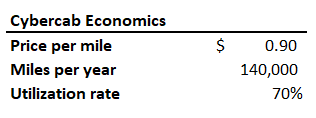
We expect Tesla’s Cybercab fleet to initially consist of individual- and Tesla-owned Tesla vehicles, with further expansion to non-Tesla vehicles equipped with FSD technology when Level 5 autonomy is expected to gain traction in 2035. The robotaxi uptake rate is expected at approximately 0.5% at initial roll-out, which is applied to estimated Tesla vehicle sales through FY 2034E. The uptake rate applied is consistent with the proportion of ride-hailing service drivers currently in the U.S. compared to the American passenger vehicle population. The uptake rate is expected to expand further to about 4% in the longer-term, as the global passenger vehicle fleet equipped with Level 5 autonomy and ensuing adoption of the technology increases beyond FSD-equipped Teslas.
As a result, we estimate Tesla to generate revenue of about $300 million at the initial roll-out of its Cybercab fleet, consisting of non-Tesla-owned vehicles. The non-Tesla-owned fleet is expected to generate revenue at a 57% 10-year CAGR through FY 2039E.
In addition to non-Tesla-owned vehicles, the Cybercab fleet will also consist of company-owned Teslas. This is consistent with Musk’s remarks that Tesla’s robotaxi operations will also consist of cars that the company “owns itself and operates in the fleet.” We expect the initial roll-out of Cybercab will consist of about 250 Tesla-owned vehicles, with gradual expansion to 100,000 in the longer-term. We believe the size of Tesla’s owned and operated Cybercab fleet will eventually be dependent on its internal auto-inventory levels as well, given expectations for management to optimize utilization through the anticipated higher-margin revenue stream.
Musk has also touted incremental revenue opportunity from the potential outsourcing of excess in-vehicle compute capacity. Recall that Tesla’s newest vehicles are currently equipped with Hardware 4 (“HW4”) – the in-vehicle computer that functions alongside cameras and FSD software to run autonomous driving capabilities. Although Musk sees potential in monetizing the excess inference compute available in the vehicles when they are not in use, we have not yet considered relevant sales in the robotaxi forecast. This is consistent with the understanding that the distributed inference compute use case remains speculative and non-core in Tesla’s longer-term business plan.
FSD Purchases, Subscriptions and Licensing
In addition to robotaxi revenue, it is also part of Tesla’s core business model to monetize autonomous mobility through the sale of FSD subscriptions and licenses to individual car owners, as well as software licenses to auto OEMs. As mentioned in the earlier section, we have adjusted our previous FSD revenue forecast based on consideration of recent price changes, and the ensuing impact to the mix of subscription and outright license purchases among individual car owners.
Specifically, Tesla currently charges $8,000 for outright FSD license purchases in the U.S. This translates to a breakeven timeline of about 7 years, considering the subscription rate of $99 per month. Yet, the average Tesla vehicle ownership to date is about five years (versus estimated useful life of about eight years), with management currently adamant that FSD purchases be non-transferrable. As a result, we expect greater uptake of FSD subscriptions from individual Tesla owners, as opposed to outright purchases – especially as the technology has yet to receive regulatory approval for Level 5 autonomy.
In addition to regulatory approval, revenue generated from FSD sales to Tesla owners will also be dependent on overseas market penetration. This is consistent with market’s optimism observed in the stock recently after the company receives regulatory approval to expand supervised FSD capabilities into China. The company also expects to receive regulatory approval for releasing supervised FSD into additional overseas markets over the longer-term, which would further reinforce materialization of relevant cash flow projections and their ensuing impact on the stock’s valuation prospect.
In addition to FSD license and subscription sales to Tesla car owners, the company is also expected to generate revenue from licensing the software to auto OEMs in the longer-term. This is consistent with management’s recent disclosure that Tesla is already in discussion with legacy automakers in the potential licensing of FSD software, with the potential to reach at least one deal by the end of 2024. This is expected to result in FSD integration in non-Tesla vehicles over the longer-term, and yield an incremental FSD licensing revenue stream for the company.
Musk’s “Unfathomable” Pay Package
In addition to FSD developments, Musk’s pay package and his future with Tesla are also key considerations for the stock’s outlook. Specifically, Musk’s zero-salary, stock-based compensation package approved in 2018 was voided by Delaware Chancellor Kathaleen McCormick earlier this year, ruling in favor of the investor who had brought forth the complaint. The pay package, worth $56 billion based on Tesla’s stock price at the time, was deemed “unfathomable” by the judge, who went on to rebuke the Board’s lacking execution of their fiduciary duty in 2018 when the deal was reached with Musk.
“Swept up by the rhetoric of ‘all upside,’ or perhaps starry eyed by Musk’s superstar appeal, the board never asked the $55.8 billion question: Was the plan even necessary for Tesla to retain Musk and achieve its goals?” wrote Kathaleen McCormick of Delaware’s Court of Chancery.
Source: Reuters.
In response to the ruling, Tesla has sought clarity from shareholders by holding a vote on the pay package during its 2024 annual meeting. About 77% of Tesla shareholders voted supporting Musk’s pay package. However, this does not immediately reinstate the pay package for Musk. Instead, results from the shareholder vote will be used as supporting evidence at a hearing before Judge McCormick scheduled for late July / early August in determining the final decision on Musk’s 2018 pay package.
Yet, some are worried that the shareholders’ overwhelming support for reinstating Musk’s 2018 pay package might be viewed as “the product of coercion,” which could make it invalid. Specifically, Musk has long reaffirmed his stance that he is uncomfortable with pursuing AI and robotics developments at Tesla, and will instead take relevant R&D elsewhere, unless he gains 25% ownership in the company. This has accordingly increased the importance of maintaining Musk’s leadership at Tesla, given his presence remains a critical determinant of the core technology that underpins the company’s future fundamental performance and, inadvertently, valuation prospects.
Another downside consideration is that the judge may view shareholders’ current support for Musk’s 2018 pay package as a decision made based on hindsight. Specifically, Tesla’s growth and ensuing value appreciation to date since 2018 can be viewed as a significant influence on the level of support that shareholders have for Musk today. Yet, this consideration factor was unavailable in 2018 when the pay package was conceived and subsequently approved by the Board.
Looking ahead, the separate hearing scheduled by Judge McCormick for “late July or the first week in August” to consider recent results from the shareholder vote on Musk’s 2018 pay package is likely to be a key determining of the stock’s near-term outlook. On one hand, if the judge rules in favor of reinstating Musk’s 2018 pay package, it would lift a key risk overhang on the stock. Meanwhile, on the other hand, if the judge reaffirms the previous verdict to void Musk’s 2018 pay package, the Board will likely have to return to the drawing board.
In addition to the incremental costs of drafting a new pay package, a reaffirmed unfavorable ruling from the judge will likely increase risk sentiment for the stock in the near-term as well. Specifically, Tesla estimates an incremental accounting charge of more than $20 billion should they have to curate a new compensation package today that would match “the same economic benefit” as the one forged in 2018 for Musk. To avoid the incremental accounting charge on top of the $2.3 billion already booked for the original pay package issued in 2018, the new package would need to be “less than 10% of the size of the 2018 plan” – a highly unlikely outcome given Musk’s demands for increased ownership in the company to progress with developments in AI and robotics at Tesla.
While the judge’s decision remains uncertain, it is likely Tesla’s Board will pursue a pay package that complies with both legal and independence considerations with shareholders’ support for Musk, nonetheless. This is because Musk’s leadership at Tesla remains a key prerequisite to the materialization of all growth prospects currently planned for the company, which also happens to underpin the stock’s lofty valuation premium at current levels. Without Musk at the helm, Tesla’s robotaxi and FSD ambitions that have been driving the stock’s performance could potentially become a moot point. Although Musk has reaffirmed that Tesla will inevitably “solve autonomy” even in the event of his absence, expectations for a slower progression will likely harbinger incremental execution risks and levy an adverse impact on the company’s valuation.
Fundamental Considerations
Adjusting our previous forecast for Tesla’s latest 2Q24 delivery numbers, and recent vehicle price changes observed across the core U.S. and Chinese markets, we expect automotive sales of $75.7 billion for 2024, which would represent a -4% y/y decline. Our forecast expects flat full year 2024 vehicle deliveries compared to 2023 based on 1H24 volumes and forward demand considerations. Specifically, the accelerated launch of new models – including “more affordable” options – as soon as late this year, alongside ongoing macroeconomic uncertainties, is likely to drive a hold out in consumer purchases and impact 2024 auto delivery volumes at Tesla. Auto delivery volumes are likely to reaccelerate through 2025E, driven primarily by the introduction of more affordable models to better address mass market demand. This couples with a reduced ASP going forward, given expectations for a greater shift in automotive sales mix towards the lower priced Tesla models.
Meanwhile, expectations for reacceleration in regulatory credit sales through the remainder of the year driven by reduced EV investments across competing auto OEMs, as well as the robust demand environment for Tesla’s energy generation and storage solutions will be key to offsetting the anticipated automotive sales decline this year. We forecast full year 2024 revenue of $94.8 billion for Tesla, which would represent a y/y decline of -2%.
Price Considerations
Our updated price target for Tesla, which takes into additional consideration of robotaxi contributions and updated FSD sales prospects, is $220 apiece.
The price is derived using the sum-of-the-parts methodology, which considers the estimated intrinsic value attributable to each of Tesla’s automotive, FSD, robotaxi, and energy generation and storage businesses.
Author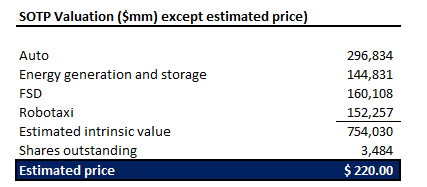
Automotive
We estimate an intrinsic value of $296.8 billion for Tesla’s core auto business. The estimate applies a 6.3x multiple on 2033E automotive sales, which is in line with the average observed across Tesla’s megacap peers with a similar growth profile. This offers a better valuation outlook for Tesla’s automotive business relative to legacy auto OEMs, considering its first-mover advantage in connected electric vehicles, supported by industry-leading manufacturing capabilities and vertically integrated infrastructure. A 9% WACC derived based on Tesla’s capital structure and risk profile is also applied to discount the estimated 2033E value back to 2024.
Author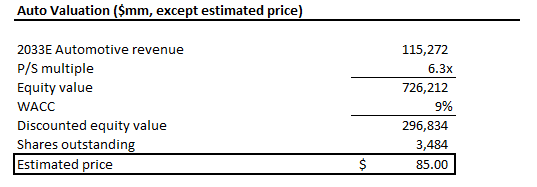
Energy Generation and Storage
We estimate an intrinsic value of $144.8 billion for Tesla’s energy storage and generation business. The valuation estimate assumes a 6.3x sales multiple on 2033E energy storage and generation revenue. The valuation premium attributable to Tesla compared to average multiples observed across the legacy energy generation and storage industry is warranted, in our opinion, given the company’s proprietary technologies in the field and its higher growth outlook. This is consistent with the segment’s accelerating growth observed in recent quarters, which management expects to persist based on improved revenue visibility. A 9% WACC is also applied to discount the estimated 2033E value back to 2024.
Author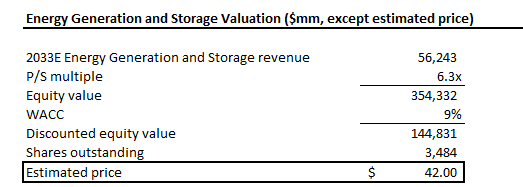
FSD
We estimate an intrinsic value of $160.1 billion for Tesla’s FSD business, which consists of outright license sales and subscriptions to individual car owners, as well as license sales to third-party OEMs. The estimate applies a 10x multiple on estimated 2033E FSD revenue, which is in line with the average observed across high-growth (30%+) software sector peers that exhibit a similar profit margin trajectory. A 9% WACC is also applied to discount the estimated 2033E value back to 2024.
Author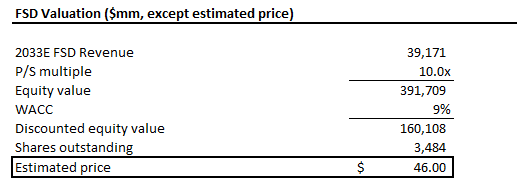
Robotaxi
We estimate an intrinsic value of $152.3 billion for Tesla’s robotaxi / Cybercab business. A 10x multiple is applied on estimated 2039E robotaxi revenue, which is consistent with the methodology applied for Tesla’s FSD operations given their similarly high growth, high margin business model. A 9% WACC is applied to discount the estimated 2033E value for Tesla’s robotaxi operations back to 2024.
Author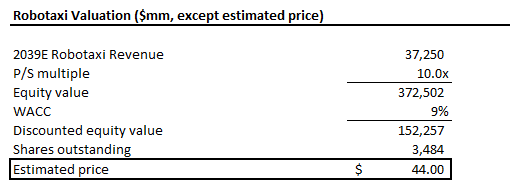
Conclusion
The stock’s favorable upsurge following the release of Tesla’s 2Q24 delivery outperformance corroborates the growing pivot of investors’ focus towards its autonomous mobility capabilities instead. A similar trend is likely leading up to Tesla’s 2Q24 earnings update, whereby investors’ expectations for updates related to more affordable models, FSD and robotaxis will likely overshadow anticipated near-term weakness in automotive revenue, and keep the stock resilient at current levels.
Alternatively, we expect the Tesla stock to face an inflection point in early August when the robotaxi unveiling event and the judge’s final decision on Musk’s 2018 pay package takes place. We believe both events will drive near-term volatility for the stock, with further upside from current levels dependent on the ensuing start of productions and follow-up demand environment for the more affordable vehicles exiting 2024.
Specifically, the roll-out of a more affordable vehicle – albeit potentially dilutive to profit margins despite a lower-cost platform – will be key to sustaining Tesla, Inc.’s longer-term growth trajectory. This is because future FSD and robotaxi cash flows currently underpinning the stock’s lofty premium remains heavily dependent on Tesla’s global fleet size. With slowing uptake for Tesla’s existing line-up, incremental market share gains will likely depend on deeper penetration into more price sensitive mass market consumers with a lower priced model than the current Model 3/Y. This would also improve Tesla’s currently stalled appeal in China – one of its core markets – as primarily price sensitive consumers in the region have been showing an increased preference for budget models like those offered by BYD Company (OTCPK:BYDDF, OTCPK:BYDDY).
Editor’s Note: This article discusses one or more securities that do not trade on a major U.S. exchange. Please be aware of the risks associated with these stocks.
